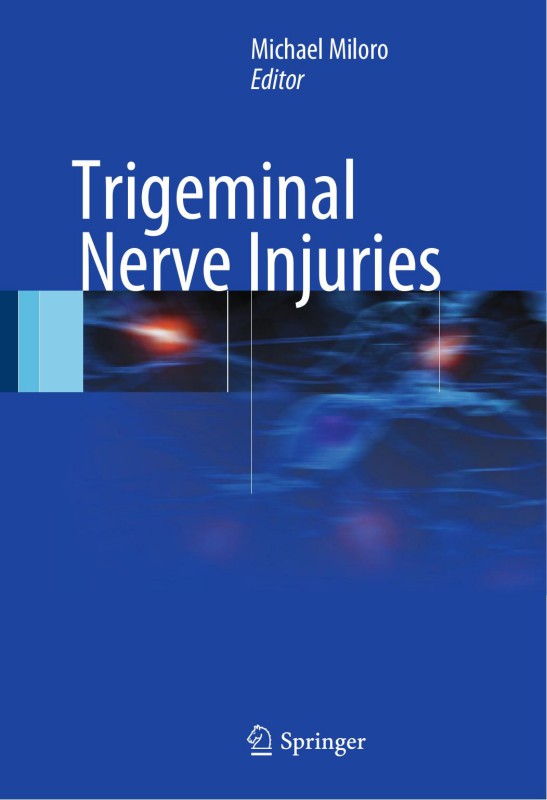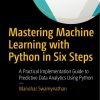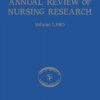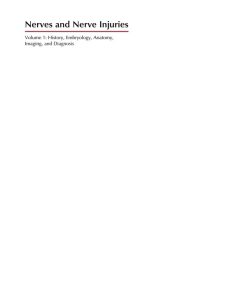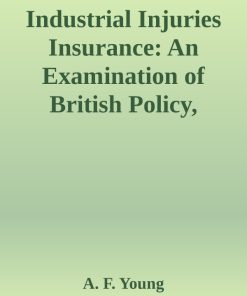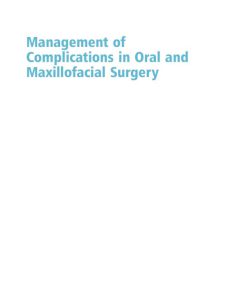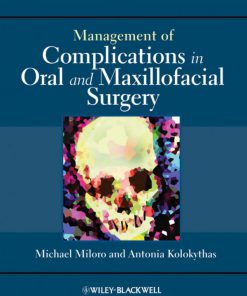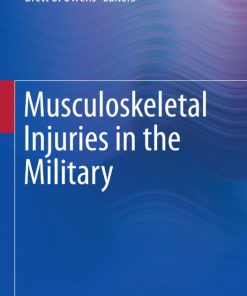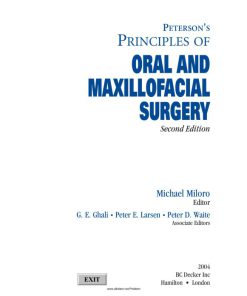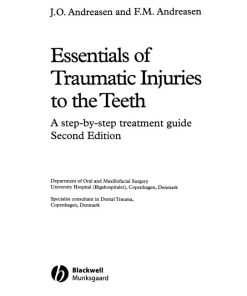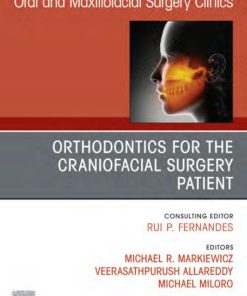Trigeminal Nerve Injuries 1st Edition by Michael Miloro ISBN 9783642355394 3642355390
$50.00 Original price was: $50.00.$25.00Current price is: $25.00.
Authors:Springer; 2013 edition (June 12, 2013) , Author sort:edition, Springer; 2013 , Published:Published:Apr 2013
Trigeminal Nerve Injuries 1st Edition by Michael Miloro – Ebook PDF Instant Download/Delivery. 9783642355394 ,3642355390
Full download Trigeminal Nerve Injuries 1st Edition after payment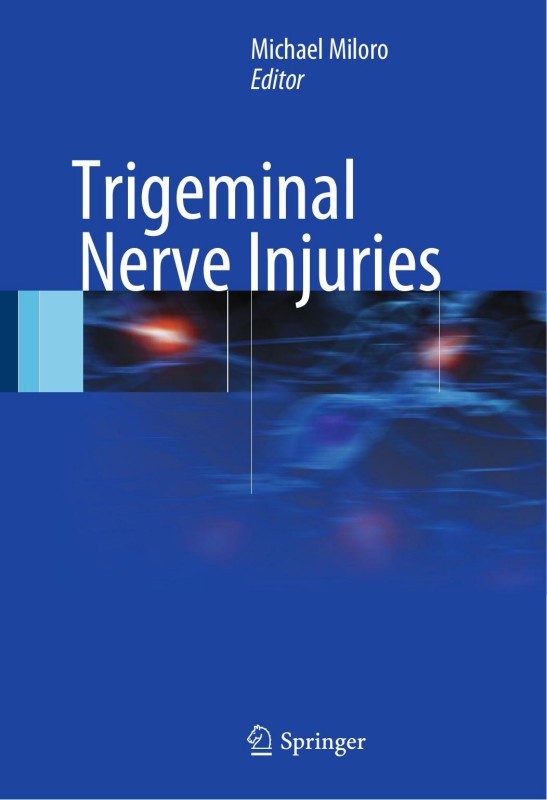
Product details:
ISBN 10: 3642355390
ISBN 13: 9783642355394
Author: Michael Miloro
Trigeminal Nerve Injuries 1st Edition Table of contents:
1: Historical Perspectives on Trigeminal Nerve Injuries
1.1 The Beginnings of Knowledge
1.2 The Clinical Features of Nerve Injuries: Lessons from the Historic Wars
1.3 Treating Nerve Injuries in the Early Twentieth Century: Neural Ablation
1.4 The Emergence of Balanced and Multidisciplinary Nerve Treatments
1.4.1 Neural Blockade
1.4.2 Neural Stimulation
1.5 Legacies of WW II and Beyond: Understanding Mitchell’s Observations
1.6 The Push Toward Nerve Repairs
1.7 Twenty-First-Century Consensus: “The Triumphant Trigeminal”
1.7.1 Lingual Nerve Injuries
1.7.2 Surgical Repair
1.7.3 Timing of Nerve Repairs
1.7.4 Microsurgical Nerve Repair
1.7.5 Entubulation
1.7.6 Diagnostic Assessment
1.7.7 Trigeminal Injury Epidemiology
1.8 Unfinished Business
1.8.1 Epidemiology
1.8.2 Clinical Diagnostic Methods
1.8.3 Traumatic Trigeminal Neuralgia
1.8.4 New Surgical Options
1.8.5 Professional Education
1.8.6 Healthcare Delivery
Conclusions
References
2: Classification of Nerve Injuries
2.1 Introduction
2.2 Historical Perspectives
2.3 Nerve Injury Classification via Semiquantitative Value
2.3.1 Histology
2.3.1.1 Neurapraxia
2.3.1.2 Axonotmesis
2.3.1.3 Neurotmesis
2.4 Nerve Injury Classification via Independent Classification
2.4.1 Chemical Injuries
2.4.2 Infection
2.4.3 Metabolic Disorders
2.4.4 Genetic Disorders
2.4.5 Multiple Sclerosis
2.5 Nerve Injury Classification via Subjective Reporting
References
3: Etiology and Prevention of Nerve Injuries
3.1 Introduction
3.2 Neuroanatomy
3.2.1 Supraorbital and Supratrochlear Nerves
3.2.2 Infraorbital Nerve
3.2.3 Inferior Alveolar Nerve
3.2.4 Mental Nerve
3.2.5 Lingual Nerve
3.2.6 Long Buccal Nerve
3.3 Types of Nerve Injury
3.3.1 Clinical Categories of Nerve Injury
3.3.2 Mechanisms of Nerve Injury
3.4 Incidence of Nerve Injuries
3.5 Causes of Nerve Injury
3.5.1 Local Anesthetic Injections
3.5.2 Mandibular Third Molar Removal
3.5.3 Orthognathic Surgery
3.5.4 Maxillofacial Trauma
3.5.5 Dental Implants and Preprosthetic Surgery
3.5.6 Endodontic Treatment
3.5.7 Salivary Gland Surgery
3.5.8 Ablative/Oncologic Surgery
3.5.9 Cosmetic Surgery
3.6 Summary
References
4: Injection Injuries of the Trigeminal Nerve
4.1 History
4.2 Incidence of Injection Injuries
4.3 Clinical Features and Nerve Involvement
4.4 Etiology: Needle Lesion or Neurotoxicity?
4.5 Toxicity of Local Anesthetics: Systemic and Local
4.6 Treatment Options
4.7 Preventative Measures
Conclusions
References
5: Third Molar Injuries of the Trigeminal Nerve
5.1 Introduction
5.2 Etiology and Prevention of Damage to the Lingual Nerve
5.2.1 Buccal Versus Lingual Approach for L3M Removal
5.2.2 Use of Separators to Retract the Lingual Flap
5.2.3 Use of Burs or Chisels
5.2.4 Integrity of the Lingual Cortical Plate
5.2.5 Wound Cleaning and Suture
5.2.6 Experience of the Surgeon
5.2.7 Age
5.3 Etiology and Prevention of Damage to the Inferior Alveolar Nerve
5.3.1 Germenectomy Versus Delayed Extraction
5.3.2 Radiological “Alert” Signs
5.3.3 Conventional Radiography Versus Computed Tomography
5.3.4 Ostectomy and Tooth Sectioning (Burs, Chisels, Piezosurgery, and Laser)
5.3.5 Drainage and Postoperative Dressings
5.3.6 Age
5.3.7 Anti-inflammatory Treatment
5.3.8 Coronectomy
5.3.9 Pericoronal Ostectomy
5.3.10 Orthodontic Extrusion
5.4 Evolution of LN and IAN Injury Caused by L3M Extraction
Conclusions
References
6: Dental Implant-Related Injuries of the Trigeminal Nerve
6.1 Background
6.2 Etiology of Implant-Related Nerve Injury
6.2.1 Errors in Diagnosis and Treatment Planning
6.2.2 Local Anesthetic Injection
6.2.3 Osteotomy Preparation
6.2.4 Direct Implant Placement Injury
6.2.5 Other Causes of Injury
6.3 Evaluation of Implant-Related Nerve Injury
6.3.1 Evaluation of Nerve Injuries
6.3.2 Treatment
6.4 Surgical Procedures for IAN Injuries from Dental Implants
6.4.1 Nerve Exploration
6.4.2 Dental Implant Removal
6.4.3 Nerve Repositioning
6.4.4 Excision of Neuroma
6.4.5 External Neurolysis (Decompression) and Internal Neurolysis
6.4.6 Neurorrhaphy
6.4.7 Nerve Grafts
6.5 Complications of Surgical Treatment
6.5.1 Specific Surgical Procedures
6.5.2 Expected Sensory Outcomes
6.5.3 Timing of Surgery and Age of Patient
6.5.4 Patient’s Medical Status and Risk of General Anesthesia
6.6 Postoperative Rehabilitation
Conclusions
Suggested Reading
7: Nerve Repositioning Injuries of the Trigeminal Nerve
7.1 History and Terminology
7.2 Nerve Repositioning Techniques
7.3 Patient Selection and Keys of Reducing Nerve Damage
7.3.1 Clinical and Radiographic Evaluation
7.3.2 Indications, Contraindications, and Limitations
7.3.3 Preoperative Consultation
7.3.4 Important Considerations in Nerve Repositioning Surgery
7.4 Mechanism of Nerve Injury
7.4.1 Flap Design
7.4.2 Ostectomy to Access the IAC
7.4.2.1 Nerve Lateralization
7.4.2.2 Nerve Transpositioning
7.4.3 Repositioning the Neurovascular Bundle Outside of the IAC
7.4.4 Nerve Damage During IAN Retraction from the Canal for Drilling and Implant Insertion
7.4.5 Repositioning the Neurovascular Bundle Inside the Canal
7.5 Histological Findings Associated with Nerve Repositioning and Implant Placement
7.6 Clinical Neurosensory Testing in Nerve Repositioning Patients
7.6.1 Mechanoceptive Tests
7.6.2 Nociceptive Tests
7.7 Management of Sensory Disturbances in Nerve Repositioning Cases (Surgical and Nonsurgical Appro
7.7.1 Nonsurgical Treatment Options
7.7.2 Surgical Treatment Options
7.8 Sensory Function After Nerve Repositioning Surgery
Conclusions
References
8: Orthognathic Injuries of the Trigeminal Nerve
8.1 Orthognathic Surgery
8.2 Mandibular Osteotomies
8.2.1 Sagittal Split Ramus Osteotomy (SSRO)
8.2.2 Vertical Ramus Osteotomy (VRO) and Genioplasty
8.3 Maxillary Osteotomies
8.4 Allodynia
8.5 Preoperative Considerations
8.6 New Research on Orthognathic Nerve Injuries
8.7 Recommendations
8.8 Summary
References
9: Nerve Injury and Regeneration
9.1 Introduction
9.2 Anatomy
9.2.1 Connective Tissue
9.2.2 Blood Supply
9.2.3 Nerve Fibers
9.3 Basic Injury Types
9.3.1 First-Degree Injury, Neuropraxia
9.3.2 Second-Degree Injury, Axonotmesis
9.3.3 Third-Degree Injury, Axonotmesis
9.3.4 Fourth-Degree Injury, Axonotmesis
9.3.5 Fifth-Degree Injury, Neurotmesis
9.3.6 Sixth-Degree Injury, Neuroma in Continuity
9.4 Overview of Response to Injury
9.4.1 Proximal Nerve Segment Response
9.4.2 Injury Site Response
9.4.3 Axonal Degeneration
9.4.4 The Inflammatory Response in Wallerian Degeneration
9.4.5 Schwann Cells
9.4.5.1 Proliferation and Support
9.4.5.2 Cell Adhesion Molecules (CAMs) and Extracellular Matrix Proteins
9.4.5.3 Neurotrophic Factors
9.4.6 Axonal Regeneration
9.4.7 Pathway Selection
9.4.8 Roadblocks to Regenerative Outgrowth
9.5 Summary
References
10: Clinical Evaluation of Nerve Injuries
10.1 Introduction
10.2 History
10.3 Equipment
10.4 Head, Neck, and Oral Examination
10.5 Neurosensory Testing
10.5.1 Decreased Altered Sensation
10.5.2 Unpleasant Altered Sensation
10.5.3 Diagnostic Nerve Blocks
10.5.4 Mapping
10.6 Imaging
10.7 Diagnosis and Classification
10.8 Summary
Appendices
A.1 Nerve Injury History
A.2 Nerve Injury Examination
References
11: Imaging of the Trigeminal Nerve
11.1 Introduction
11.2 General Considerations
11.3 Preoperative Radiologic Risk Assessment of the IAN and LN
11.3.1 Panoramic Radiography
11.3.2 Computerized Tomography
11.3.3 High-Resolution Magnetic Resonance Imaging (HR-MRI)
11.3.4 Ultrasonography
11.4 Post-Injury Radiographic Assessment of the IAN and LN
11.4.1 Panoramic Radiography
11.4.2 Computerized Tomography
11.4.3 Magnetic Source Imaging (MSI)
11.4.4 High-Resolution Magnetic Resonance Imaging (HR-MRI)
11.4.5 Magnetic Resonance Neurography (MRN)
11.4.6 Ultrasonography (US)
11.5 Post-Injury Functional Assessment of the IAN and LN
Suggested Reading
12: Nonsurgical Management of Trigeminal Nerve Injuries
12.1 Introduction
12.2 Trigeminal Nerve Injury Management Protocols
12.2.1 Early/Immediate Interventions
12.2.2 Later or Delayed Management
12.3 Nonsurgical Management of Trigeminal Nerve Injuries
12.3.1 Functional Morbidity
12.3.2 Pain Management
12.3.2.1 Topical Analgesia
12.3.2.2 Systemic Analgesia
12.3.3 Psychological Morbidity
12.3.3.1 Psychiatric and Psychological Therapies
CBT
Acceptance and Commitment Therapy (ACT)
Other Nonsurgical Interventions
Combined Therapies
12.4 Summary
12.4.1 Improved Management of These Injuries
References
13: Surgical Management of Lingual Nerve Injuries
13.1 Introduction
13.2 Surgical Anatomy
13.3 Indications for Surgical Management
13.4 Surgical Approach and Techniques
13.5 Outcomes
13.6 Case Presentations of LN Repair
References
14: Surgical Management of Inferior Alveolar Nerve Injuries
14.1 Criteria for Surgical Intervention
14.2 Surgical Approaches to the IAN
14.3 Surgical Procedures of the IAN
14.3.1 Interpositional Grafts
14.3.2 Inferior Alveolar Nerve Neurectomy
14.3.3 Results of IAN Repair Surgery
References
15: Surgical Management of Facial Nerve Injuries
15.1 Facial Nerve Anatomy
15.2 Etiopathology of Facial Paralysis
15.3 Evaluation
15.4 Treatment
15.4.1 Surgical Management of Acute Facial Nerve Lesions
15.4.2 Surgical Management of Established Facial Nerve Lesions
15.4.2.1 Static Slings
15.4.2.2 Regional Muscle Transfer
15.4.2.3 Free Functional Muscle Transfer
15.5 Complications and Prognosis
15.6 Future Directions
References
16: Nerve Grafts and Conduits
16.1 Considerations for Direct Nerve Repair
16.2 Considerations for Autogenous Nerve Grafts
16.2.1 Diameters of Donor and Host Nerves
16.2.2 Length of Nerve Graft Required
16.2.3 Number of Fascicles
16.2.4 Fascicular Pattern
16.2.5 Cross-Sectional Shape and Area
16.2.6 Patient Preference
16.3 Factors Affecting Nerve Graft Success
16.3.1 Time Since the Injury
16.3.2 Type and Extent of Injury
16.3.3 Vascularity in Host Bed
16.3.4 Orientation of Nerve Graft Placement
16.3.5 Length of Nerve Graft Required
16.3.6 Quality and Type of Repair
16.3.7 Tension on Repaired Nerve
16.3.8 Preparation of the Host Nerve
16.3.9 Age of Patient and Other Health Factors
16.4 Expected Outcomes
16.5 Nerve Grafting with Other Tissues
16.6 Allograft Nerve Grafts
16.7 Alloplastic Nerve Grafts
16.7.1 Nonresorbable Materials
16.7.2 Biodegradable Synthetic Materials
16.7.2.1 Polyglycolic Acid
16.7.2.2 Polyesters and Copolyesters
16.7.2.3 Collagen
16.8 Molecular and Cell Therapy
16.9 Summary
References
17: Complications of Trigeminal Nerve Repair
17.1 Failure to Achieve Expected Outcomes
17.2 Surgical Site Complications
17.2.1 Mandible Fracture
17.2.2 Malocclusion
17.2.3 Iatrogenic Nerve Injury
17.2.4 Trismus
17.2.5 Inappropriate Choice of Surgery
17.2.6 Transcervical Approach Morbidity
17.2.7 Development of Neuropathic Pain
17.3 Donor Site Complications
17.3.1 Sural Nerve Harvest Morbidity
17.3.2 Greater Auricular Nerve Harvest Morbidity
17.4 Medical Management Complications
17.5 Other Treatment Complications
References
18: Neurosensory Rehabilitation
18.1 Introduction
18.2 Orthognathic Surgery: An Experimental Model of Posttraumatic Nerve Injury
18.3 Biological Response to Nerve Injury
18.3.1 Peripheral Neural Response to Nerve Injury
18.3.2 Assessment of Nerve Response
18.3.3 Central Neural Response to Nerve Injury
18.3.4 Assessment of Cognitive Changes
18.4 Sensory Retraining Alters the Central Neural Response to Nerve Injury
18.5 Sensory Retraining After Injuries to the Hand
18.6 Sensory Retraining After Injuries to the Orofacial Region
18.6.1 Initial Clinical Observations
18.6.2 Findings from a Randomized Clinical Trial
18.7 Vitamin B12 Alters the Peripheral Neural Response to Nerve Injury
18.8 Vitamin B12 After Injuries to the Orofacial Region
18.8.1 Intranasal Vitamin B12 Is Well Tolerated
18.8.2 Intranasal Vitamin B12 Alters the Course of Sensory Impairment
18.8.2.1 Contact Detection
18.8.2.2 Two-Point Perception
18.8.2.3 Thermal Sensibility
References
19: Outcomes of Trigeminal Nerve Repair
19.1 Introduction
19.2 Outcomes of Lingual Nerve Repair
19.2.1 Introduction
19.2.2 Patients and Methods for UK Analysis
19.2.3 Outcome of UK Analysis
19.2.3.1 Responses to Questions
19.2.3.2 Observations
19.2.3.3 Neurosensory Tests
19.2.3.4 Subjective Assessment
19.2.3.5 Effect of Delay in Repair
19.2.4 Patients and Methods for the Denmark Analysis
19.2.5 Outcome of Denmark Analysis
19.2.5.1 Subjective Assessment of Sensation
19.2.5.2 Tactile Perception
19.2.5.3 Two-Point Discrimination
19.2.5.4 Pain Perception
19.2.5.5 Factors Influencing Recovery
19.2.6 Discussion on Outcome of Lingual Nerve Repair
19.2.6.1 Is Lingual Nerve Repair Worthwhile?
19.2.6.2 Do Some Neurosensory Functions Recover Better than Others?
19.2.6.3 Does Nerve Repair Surgery Reduce Dysaesthesia?
19.2.6.4 Is Early Repair More Effective than Late Repair?
19.2.6.5 Do Other Factors Influence the Outcome?
19.3 Outcome of Inferior Alveolar Nerve Surgery
19.3.1 Introduction
19.3.2 Patients and Methods
19.3.2.1 Surgical Procedure
19.3.2.2 Neurosensory Assessment
19.3.3 Outcome of IAN Decompression and Neurolysis
19.3.3.1 Clinical Observations
19.3.3.2 Responses to Questions
19.3.3.3 VAS Scores
19.3.3.4 Neurosensory Tests
19.3.3.5 Subjective Assessment
19.3.4 Discussion on Outcome of IAN Decompression and Neurolysis
19.3.4.1 Does IAN Decompression and Neurolysis Reduce Dysaesthesia?
19.3.4.2 Does IAN Surgery Improve Sensation?
19.3.4.3 Is the Level of Improvement Obtained Worthwhile?
19.3.4.4 Other Observations
References
20: Guidelines for Diagnosis and Treatment of Trigeminal Nerve Injuries
20.1 Evaluation and Diagnosis
20.1.1 The Patient Interview
20.2 Physical Examination and Neurosensory Testing
20.3 Imaging
20.4 Surgical Treatment Guidelines
20.5 Nonsurgical Management
20.5.1 Behavioral Treatment
20.5.2 Physiologic Treatment
20.5.3 Pharmacologic Treatment
20.6 Summary
References
Glossary 1
Index
People also search for Trigeminal Nerve Injuries 1st Edition:
trigeminal neuralgia dental nerve injuries
management of traumatic trigeminal and facial nerve injuries
trigeminal nerve injury symptoms
what happens if the trigeminal nerve is damaged

